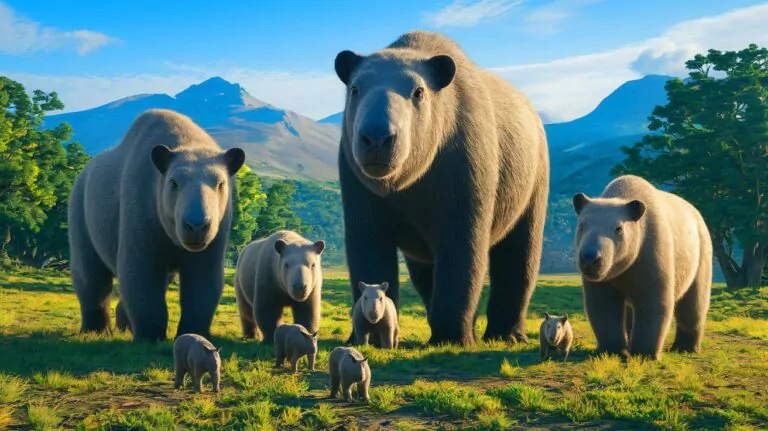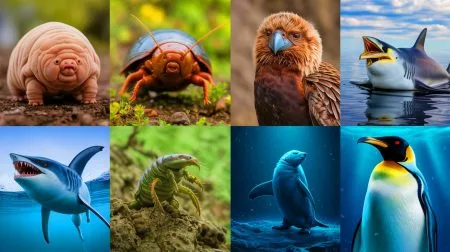| IN A NUTSHELL |
|
For millions of years, Earth’s terrestrial mammals have remained within certain size limits, bound by complex biological and environmental factors. Despite this, the prehistoric world once hosted mammalian giants whose dimensions were astonishing, though they never reached the colossal scales of the dinosaurs. The extinction of these prehistoric titans opened ecological niches that allowed mammals to evolve into larger forms, yet none ever quite matched the grandeur of the Mesozoic giants. Understanding the reasons behind this size discrepancy requires delving into the unique evolutionary paths and environmental contexts that shaped the destinies of these remarkable creatures.
Why Dinosaurs Were So Gigantic
The age of dinosaurs was defined by creatures of unimaginable size, vastly overshadowing anything the mammalian world has produced. Take the Brachiosaurus, for instance, measuring over 65 feet long and weighing up to 110,000 pounds. In stark contrast, the largest living terrestrial mammal, the African elephant, stands about 13 feet tall and weighs no more than 13,000 pounds. This size disparity is attributed to several key biological and environmental factors unique to dinosaurs.
One significant factor was their metabolism. Unlike mammals, which are endotherms and regulate their internal temperature by consuming substantial energy, dinosaurs were likely mesotherms. This intermediate metabolic state allowed them to grow rapidly while expending less energy than modern mammals. Biologist Felisa Smith highlights that mammals consume, on average, ten times more energy than a comparably sized reptile or dinosaur, thereby limiting their potential for gigantism.
“Unseen heroes in a petri dish”: these new viruses massively combat climate change now
The Mesozoic era provided an ideal environment for dinosaurs to thrive. With a warm climate and lush vegetation, herbivores grew rapidly, leading to larger predators. A study from the University of New Mexico suggests that the growth patterns of terrestrial vertebrates followed similar global trends, allowing dinosaurs to reach impressive sizes without major constraints. These favorable conditions, coupled with vast territories, supplied the necessary resources for dinosaurs to grow, unlike the more restricted environments that limited the development of terrestrial mammals.
The Evolution of Giant Terrestrial Mammals
The extinction of dinosaurs around 65 million years ago cleared ecological niches, allowing smaller mammals to flourish. During the Mesozoic, mammals often led nocturnal lives to evade large predators. With dinosaurs gone, mammals diversified rapidly, with some species achieving remarkable sizes over millennia.
Despite this evolutionary leap, no mammal ever matched the largest dinosaurs’ scale. The Paraceratherium, a relative of the rhino, weighed between 33,000 and 44,000 pounds and stood 16 feet at the shoulder. Living around 34 million years ago, this massive herbivore represents one of the largest known terrestrial mammals. John Gittleman, a biologist at the University of Georgia, notes that the independent evolution of several mammalian lineages toward similar maximum sizes suggests that giant mammals fulfilled similar ecological roles worldwide. This pattern implies that ecosystems globally responded to the same ecological constraints.
The Indricotherium, another Tertiary giant, also reached extraordinary proportions, roaming the vast Eurasian plains before vanishing. Fossil analysis has reconstructed its evolution, showing that its gigantism resulted from favorable environmental factors, such as a temperate climate and expansive, vegetation-rich grasslands. However, despite these examples of gigantism, no mammal approached the size of the largest dinosaurs, as biological and ecological limitations also played a crucial role.
Biological and Ecological Constraints
Following the dinosaurs’ extinction, terrestrial mammals experienced phases of gigantism, yet several constraints limited their growth. One primary reason is their endothermic metabolism, requiring significant energy to maintain body temperature. Dinosaurs, conversely, likely had a more energy-efficient metabolism. Mammals must continually generate heat, which Felisa Smith points out increases their food consumption significantly, curtailing their ability to achieve extreme sizes.
The environment also plays a crucial role. Sustaining an animal weighing tens of thousands of pounds requires immense food resources and a sufficiently large habitat to ensure a continuous supply. Dinosaurs thrived in an era of abundant vegetation and warm climate, promoting increased food production. In contrast, mammals evolved amid more varied conditions, sometimes marked by glacial periods or prolonged droughts, limiting their potential for extreme growth.
Geographical conditions further influence these evolutionary dynamics. The study published on Phys.org highlights the correlation between an animal’s habitable territory and its evolution toward larger sizes. Larger, barrier-free territories can support bigger creatures. However, the Cenozoic continents were more fragmented than those of the Mesozoic, reducing opportunities for large mammal expansion.
Mammalian evolution has imposed limits that neither their metabolism nor anatomy can surpass. For 140 million years, they remained small and inconspicuous to avoid competing with dinosaurs. After their extinction, mammals rapidly diversified, but this expansion halted around 42 million years ago. Felisa Smith demonstrated this by studying fossil records. From then on, their size seems to have reached an evolutionary ceiling, as energetic and ecological constraints hindered further development.
As we reflect on the evolutionary history of terrestrial mammals, it’s evident that a complex interplay of factors has shaped their size limits. While they have achieved remarkable diversity and adaptation, they have not reached the towering heights of their dinosaur predecessors. With ongoing research and discoveries, what new insights might we uncover about the future potential of mammalian gigantism and its ecological implications?
Did you like it? 4.4/5 (22)








Wow, so dinosaurs were basically eco-friendly giants? 🦕
So why haven’t mammals grown larger even after all these years? 🤔
Reread the article, Patricia, to obtain the answer. Hint: ecological favorability and large tracts of geographically homogeneous environments.
AI art in your news article is an abomination.
Because we are warm blooded. It would take way to much food to keep that big a body warm. Our relatively small size allowed us time to think of better ways to hunt. That led to farming and that led to even more time to think so on and so on.
Nice article. It really puts things into perspective. 😮
I am still skeptical. Elephants, Rinos, Crocs have lived in warm climate for a long time. Mamouths were large in cold climates. For some reason I suslect the planet changed by the impact. Stronger gravitation maybe with increased mass and rotation from the impact permanently limits any sizes like prior impact. Did airborne dinos also share this modified metabolism and habitat fod their large size? I suspect a planetary limitation due to the impact. Can we measure gavitational change before and after impact? A number value?
Thanks!
That is not a brachiosaurus….
Blue Whales are the largest sea animals ever. So what capped oceanic dinosaurs?
But what about climate change? Could that impact mammal sizes?
So dinosaurs had it easy with all that abundant vegetation, huh? 😂
I’m so sick of false information first of all a Brachiosaurus is a huge freaking lizard and I mean huge it is not a big fuzzy mammal I don’t know if you’re comparing a Brachiosaurus to the pics??? Wow
The use of AI art in your article is an embarrassment to journalism.
Can you explain more about the mesotherm concept for dinosaurs?
Interesting how energy consumption plays such a big role in size limits.
Seems like the dinosaurs had all the luck with their environment! 🌿
Isn’t it a bit sad that mammals will never reach those colossal sizes?
Cool discovery! Any chance of seeing these prehistoric giants come back? 🦖
What about birds? They are dinosaurs too, right?
WHY was the OXYGEN rich atmosphere not mentioned?
Interesting article, but I’m skeptical about the metabolism theory. Any sources?
Loved the article, but I wish it was longer!
Does this mean the age of giant mammals is officially over?
The science behind this is mind-blowing. Thanks for the insights! 🔬
I can’t imagine a world where mammals are as big as dinosaurs. 😲
Why did dinosaurs grow so large in the first place?
This was a great read! Learned something new today.
Could human influence change these evolutionary patterns in the future?
So mammals are stuck being smaller? That’s a bummer. 😒
Does this apply to marine mammals too, or just those on land?
I’m curious about how these constraints apply to extinct giant mammals.
Are there any current species that might defy these size limits?
Great article, though I’m not convinced we’ve reached the size limit yet.
Wow, I had no idea dinosaurs were so energy-efficient! 🤯
Thanks for sharing this! It’s fascinating how different evolutionary paths can be. 🌱
Wait, are you saying we won’t have giant elephants in the future? 🐘
Reread the article, Patricia, to obtain the answer. Hint: ecological favorability and large tracts of geographically homogeneous environments.
What about whales? Aren’t they bigger than some dinosaurs?
The largest animal that ever lived is the Blue whale. And it’s still alive. And it lives in the ocean where it has to expend massive amounts of energy to maintain heat.
Great read! The ecological constraints make a lot of sense.
I’m so sick of false information first of all a Brachiosaurus is a huge freaking lizard and I mean huge it is not a big fuzzy mammal I don’t know if you’re comparing a Brachiosaurus to the pics??? Wow
Is there any chance that modern mammals could evolve to be bigger?
Blue whales are considered to be the largest mammal to have ever lived. Some of them clock in around 350,000 pounds and they’re still with us.
During the mesozoic era the potentially higher air pressure 3 to 5 times might also have reduced the weight of dinosaurs. Much like water does. This may have also contributed to allowing much larger animals to grow. The magic of CO2 between 1000 and 3000 parts per million!
Why is this discovery “unbelievable”, and what exactly is the warning?
This article is misleading and even contradicts itself. Plus that’s not a brachiosaurus in the first picture.
I find it very odd that a news source claiming to be ecologically friendly is using so much AI art. Ai has an atrociously high ecological impact.
The subtitle of the article doesn’t match the article. It’s something about vinyl records.
Whales?
Because we are warm blooded. It would take way to much food to keep that big a body warm. Our relatively small size allowed us time to think of better ways to hunt. That led to farming and that led to even more time to think so on and so on.
Amazing how you can say the same thing 10 times in slightly different ways and make the article this long
This article repeats itself at least twice. Was this Ai?
That’s not a Brachiosaurus…